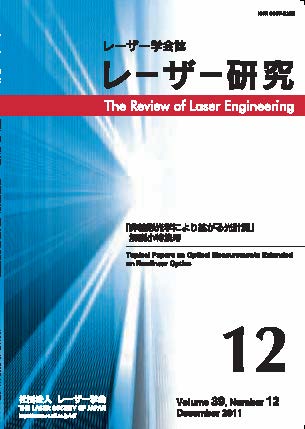All issues

Volume 49, Issue 8
Special Issue on Forefront of Laser Devices for Next Generation Lighting
Displaying 1-6 of 6 articles from this issue
- |<
- <
- 1
- >
- >|
Special Issue on Forefront of Laser Devices for Next Generation Lighting
Special Issue
Laser Review
-
[in Japanese]2021Volume 49Issue 8 Pages 444-
Published: 2021
Released on J-STAGE: April 11, 2024
JOURNAL FREE ACCESSVarious laser lightings have been developed. This special issue covers not only red, blue and green laser diodes, but also vertical cavity surface emitting lasers and optical systems. In this paper, we describe on an overview of laser devices for next generation lighting.View full abstractDownload PDF (362K) -
[in Japanese]2021Volume 49Issue 8 Pages 446-
Published: 2021
Released on J-STAGE: April 11, 2024
JOURNAL FREE ACCESSRecently, visible laser diodes have been rapidly improving their performance as the laser lighting and display market has grown. Laser displays are very attractive, because of their low electric power consumption and their wide color gamut. The small etendue of laser sources is a great advantage for downsizing the laser systems. Lighting applications using lasers are also recognized as being attractive, and are being affected by the evolving laser display technologies. In this article, the latest laser lighting technology, applications, and prospects using visible laser diodes are introduced.View full abstractDownload PDF (561K) -
[in Japanese], [in Japanese]2021Volume 49Issue 8 Pages 451-
Published: 2021
Released on J-STAGE: April 11, 2024
JOURNAL FREE ACCESSWe reviewed the current status and future prospects of red broad area laser diodes (BA-LDs) and emphasized their output power and wall plug efficiency (WPE). As a countermeasure to catastrophic optical damage (COD),which limits lifetimes, 4.0 W CW operation is expected under a condition where the lifetime exceeds 20000 hours. A WPE of 40% was also achieved. The optical gain of the 660-nm-band LD, which is suitable for artificial plant cultivation, was close to that of the 638-nm LD. Therefore, the output power and the efficiency of 660-nm-band LDs are also expected to improve in the future as 638- nm LDs.View full abstractDownload PDF (905K) -
[in Japanese], [in Japanese], [in Japanese], [in Japanese]2021Volume 49Issue 8 Pages 456-
Published: 2021
Released on J-STAGE: April 11, 2024
JOURNAL FREE ACCESSGaN-based blue and green laser diodes (LDs) have already been widely adopted in light sources for laser display systems. The authors explain the status of the development for blue and green LDs and discloses new high-power blue and green LDs based on a c-plane GaN substrate which Nichia has recently fabricated. The optical output power and wall-plug efficiency of blue LDs with an operating current of 3.0 A was 5.67 W and 48.1%,respectively. Additionally, this paper introduces some LD packages that incorporate the recently developed blue/green LDs and those packages are used for the light sources of laser projectors, digital cinema, laser head lights, etc.View full abstractDownload PDF (699K) -
[in Japanese], [in Japanese], [in Japanese], [in Japanese]2021Volume 49Issue 8 Pages 461-
Published: 2021
Released on J-STAGE: April 11, 2024
JOURNAL FREE ACCESSRetinal scanning image projection technology has unique characteristics that provide a clear image regardless of the viewer’s visual acuity or focus position. This paper describes its optics configuration and design principles for high resolution and focus-free characteristics and concentrates on semiconductor laser specification of image projection performanceView full abstractDownload PDF (1229K) -
[in Japanese], [in Japanese], [in Japanese]2021Volume 49Issue 8 Pages 467-
Published: 2021
Released on J-STAGE: April 11, 2024
JOURNAL FREE ACCESSThis paper reviews the latest progress of Gallium-nitride (GaN)-based Vertical-Cavity Surface-Emitting Lasers (VCSELs), briefly showing the typical structures previously reported and the characteristics such as efficiency, wavelength, emission angles, modes and applications.View full abstractDownload PDF (661K)
- |<
- <
- 1
- >
- >|